Attainment Scotland Fund evaluation: implementation and impact report 2024
This report shares implementation and impact evaluation evidence since the Scottish Attainment Challenge (SAC) refresh in 2022, utilising quantitative evidence gathered via a SAC Local Authority Leads Survey 2024, and qualitative evidence gathered through national stakeholder interviews.
Section 3: Implementation
How did local authorities implement the Strategic Equity Fund alongside Pupil Equity Fund and Care Experienced Children and Young People Fund?
Evidence gathered sought to generate further learning of the experiences of local authorities in implementation of the different strands of the Attainment Scotland Fund in the second year of its operation under the revised Scottish Attainment Challenge Mission. This builds on insights gathered in reporting on the first year of revised Scottish Attainment Challenge which introduced Strategic Equity Funding, the new strategic element of Attainment Scotland Funding provided to each of the thirty-two local authorities in Scotland[20].
This section covers seven key aspects with regard to implementation:
- Local government structures, workstreams and governance arrangements;
- Development of Stretch Aims;
- Planning for ASF: what worked well and what could be improved?;
- Approaches to closing the poverty-related attainment gap;
- Pupil Equity Funding (PEF);
- Care Experienced Children and Young People (CECYP) Fund;
- Alignment with other policies at local authority level.
Local government structures, workstreams and governance arrangements
Local authority structures, workstreams and governance arrangements to support planning continue to play an important role.
Findings from evidence considered includes:
- Whilst it is difficult to specify the number of posts associated with the Scottish Attainment Challenge, a review of Local Authority Scottish Attainment Challenge resource plans highlights the range and number of posts at the local authority level supported by ASF.
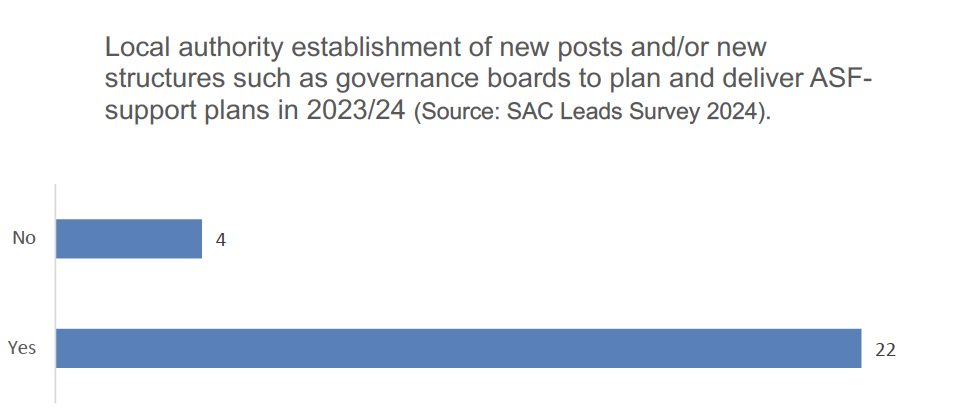
- The majority of SAC Leads Local Authority Survey 2024 respondents indicated the establishment of new posts and/or new structures such as governance boards to plan and deliver ASF-supported plans in 2022/324 (see Figure 1 above[21]).
- Additional posts to enhance central capacity were outlined as well as posts for specific aspects. For example, a number of local authorities created Virtual School Headteacher posts in 2023/24 through CECYP Funding.
Development of Stretch Aims
The requirement for local authorities to set ambitious, achievable Stretch Aims for progress in overall attainment and towards closing the poverty-related attainment gap was introduced as a requirement of the Scottish Attainment Challenge Framework for Recovery and Accelerating Progress. Initially, local authorities submitted stretch aims for the 2022/23 year[22]. For 2023/24 – 2025/26, local authorities were required to set multi-year stretch aims for the three year period.
The evidence gathered suggests the following findings in relation to Stretch Aims across 2023/24 – 2025/26:
- Findings from the SAC Leads Survey 2024 show that, similar to the development of the first set of Stretch Aims in 2022/23, robust analysis of data and evidence, including contextual evidence combined with stakeholder consultation and the role of central local authority officials were of key importance.
- The process of developing Stretch Aims was broadly described as iterative and collaborative. A number of local authorities highlighted the ‘bottom up’ nature of the approach ie using data from school level to create local authority wide data, and combining this with central team intelligence to develop a draft set of Stretch Aims to share with stakeholders, prior to finalising Stretch Aims following incorporation of stakeholder feedback.
- The SAC Leads Survey 2024 findings indicate that in terms of stakeholder engagement, central local authority officers, Attainment Advisors and headteachers were involved in development of Stretch Aims across local authorities to a greater extent. There was more limited involvement of classroom teachers, pupils, parents/carers, wider community or third sector/partners. This is very similar to the SAC Leads Survey 2023 findings, suggesting that there has been limited change in terms of stakeholder engagement in the second set of Stretch Aims.
- There was a perception amongst some national stakeholders that in some instances headteachers, particularly primary schools headteachers, were less engaged in defining Stretch Aims, suggesting a more ‘top down’ approach. There was also limited engagement in the process of developing Stretch Aims by Virtual School Headteachers.
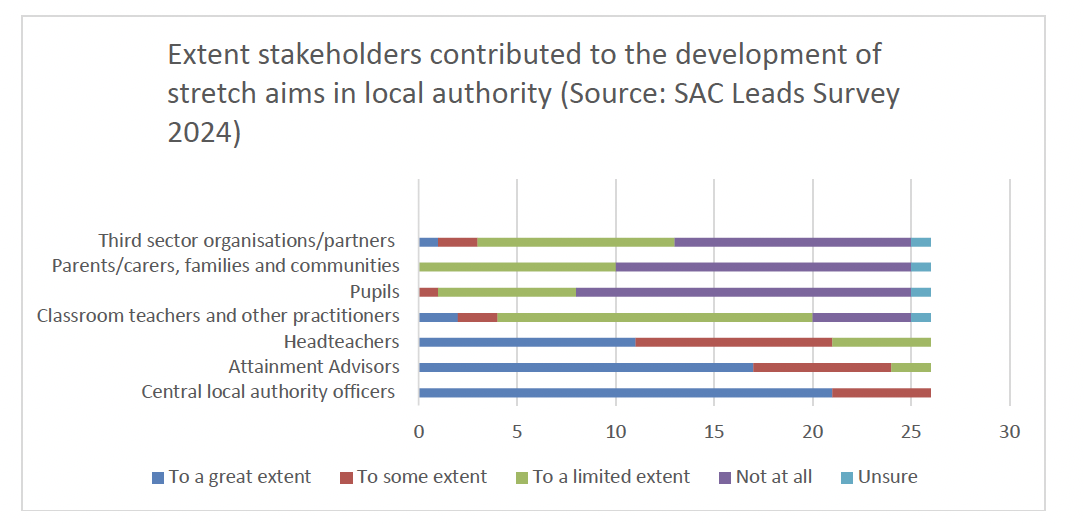
- Local authorities responding to the SAC Leads Survey 2024 broadly indicated that the approach to developing Stretch Aims for 2023/24 - 2025/26 had improved in comparison to the first set of Stretch Aims 2022/23. A small number of local authority SAC Leads respondents also described specific approaches to support school level stretch aims. Expectations that School Improvement Plans show links to contributing to the achievement of local authority Stretch Aims were noted. One local authority survey respondent particularly noted that improved processes introduced in their local authority for identifying and agreeing the ‘plus’ Stretch Aims had worked well in their planning this year.
- Several broad concerns were raised in national stakeholder interviews in relation to the overall approach to Stretch Aims. This included concerns about setting what could be viewed as ‘targets’. This was noted particularly by one national stakeholder interviewee who described Stretch Aims as ‘unrealistic’ at a time of local cuts to budget. There was also concern expressed regarding the extent to which some core Stretch Aims were able to capture progress in some local contexts. For example, it was noted that for local authorities with low number of pupils in either SIMD 1 and/or 5[23], the comparative data between SIMD Q1 and SIMD Q5 is not feasible or meaningful.
Planning for ASF: what worked well and what could be improved?
In terms of what worked well and could be improved in planning for ASF, the evidence gathered suggests:
- Local authority respondents to the SAC Leads Survey described a range of views in relation to what is working well in planning for ASF in their local authority in 2023/24. There is evidence of enhanced and more ‘joined up’ approaches to planning across local authorities, with the need for clear strategic planning and alignment around central themes, the use of data and evidence, collaborative and partnership working all highlighted.
- The importance of professional learning to support understanding was also highlighted by SAC Leads Survey 2024 respondents. This was viewed as of key importance when linked to use of data and evidence, as illustrated in the quote below:
‘Due to a range of professional learning inputs for school leaders and staff, our school communities have a strong understanding of how to identify the gap in their setting and implement strategies to address this. This is well supported by the range of data available to and used by schools to target groups and individuals. This has ensured that PEF is maximised for all learners.’
- CECYP Fund planning was positively highlighted by a number of survey respondents, with improved processes for planning, consultation, appointment of Virtual School Headteachers, improved tracking and targeting of interventions all highlighted[24].
- Where local authority respondents described aspects which could have been improved in planning for ASF in their local authority in 2023/24, suggestions raised included strengthening the voice of parents, children and young people, and an enhanced role for the third sector, in planning and implementing ASF. This mirrors aspects raised in the SAC Leads Survey 2023 related to the need for wider stakeholder engagement, particularly in terms of engagement of children and young people in planning processes.
- In a small number of local authority responses, the need to further strengthen strategic oversight, and to address ongoing issues related to the frequency of reporting and the level and uncertainty around resources were also raised.
- National stakeholder perspectives on planning and reporting were varied. Whilst some interviewees did not comment as they did not feel they were close enough to the issue, one issue which did emerge related to the high degree of variation across local authorities in terms of approaches to planning and reporting, with a suggestion made to ‘regularise’ planning and reporting at the Scottish Government level to prevent such variability.
Approaches to closing the poverty-related attainment gap
How do the approaches for equity support pupils (and parents/carers) from the most socio-economically disadvantaged backgrounds?
The evidence considered suggests that local authority approaches to closing the poverty-related attainment gap continued to evolve and develop. More specifically, the following aspects emerged from the evidence considered:
- In terms of the three organisers underpinning the Scottish Attainment Challenge, all respondents to the SAC Local Authority Leads Survey 2024 viewed their local authority approaches were based on Learning and Teaching. For twenty-four, this was to a great extent, for one to some extent and for one to a limited extent.
- All respondents viewed their local authority approaches were also based on Leadership and on Families and Communities, but to a slightly lesser extent than Learning and Teaching. Nineteen respondents indicated approaches were based on Leadership to a great extent, six to some extent and one to a limited extent. For Families and Communities, fifteen respondents indicated their approaches were based on Families and Communities to a great extent, eight to some extent and three to a limited extent. This is outlined in Figure 3 below.
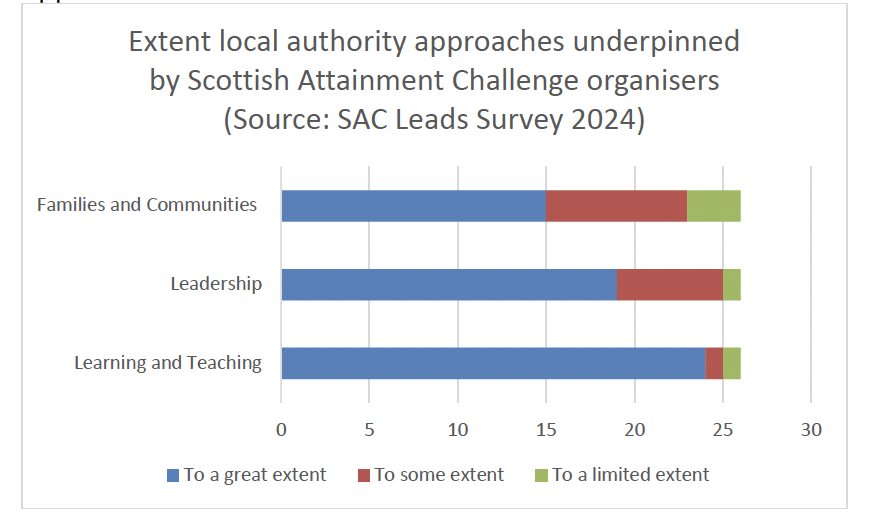
- A number of national stakeholders highlighted perceptions of a shift over time towards a greater focus on understanding the problems and challenges associated with poverty, such as cost of the school day, whereas in the early phases learning and teaching was viewed as the primary focus.
- The increasing focus through PEF for schools being able to address financial barriers being experienced by families was viewed very positively, noting the need for this to be embedded in order to start addressing the poverty-related attainment gap. Similarly, a number of national stakeholder interviewees highlighted the increased importance on focusing on health and wellbeing, not least as a result of the ongoing impact of the COVID-19 pandemic.
- Local authorities responding to the SAC Leads Survey 2024 were invited to indicate the extent to which they viewed approaches in their local authority context were:
- embedded effectively in the local setting,
- effective within the local context,
- evidence-based,
- demonstrating evidence of impact,
- addressing sustainability.
As outlined in Figure 4 below, respondents viewed their approaches as being embedded effectively in the local setting, effective within the local context, evidence based, demonstrating evidence of impact and addressing sustainability. However, perceptions of the extent to which approaches were addressing sustainability were considerably less[25].
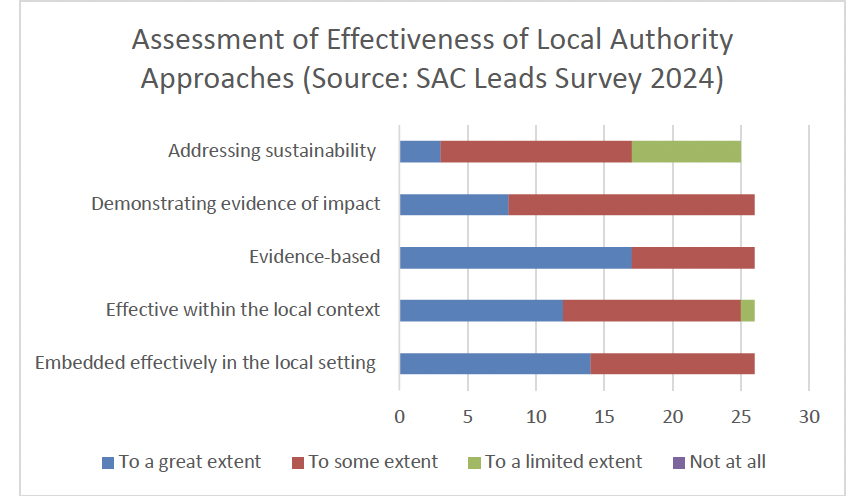
- Amongst national stakeholder interviewees, there was some recognition of a change of emphasis over time towards planned strategic approaches rather than short-term interventions which were seen as more of a feature of the initial phase of SAC.
- National stakeholder interviewees were positive overall about the work of the SAC National Programmes being more connected and embedded with the wider work of the Attainment Scotland Fund than had been the case during the early years of the Scottish Attainment Challenge, with the creation of increased opportunities for collaboration. The development in 2023/24 of link individual Attainment Advisors working directly with the third sector organisations receiving funding through the SAC National Programmes was viewed positively.
Pupil Equity Funding (PEF)
Views of implementation of Pupil Equity Funding were broadly positive in the evidence considered. Specifically, the evidence reviewed suggests that:
- Views on PEF expressed in the SAC Leads Local Authority Survey 2024 were broadly very positive, with all respondents to the SAC Leads Survey 2024 indicating that PEF is effectively invested, that spend is based on locally identified needs, and that spend is based on effective use of evidence.
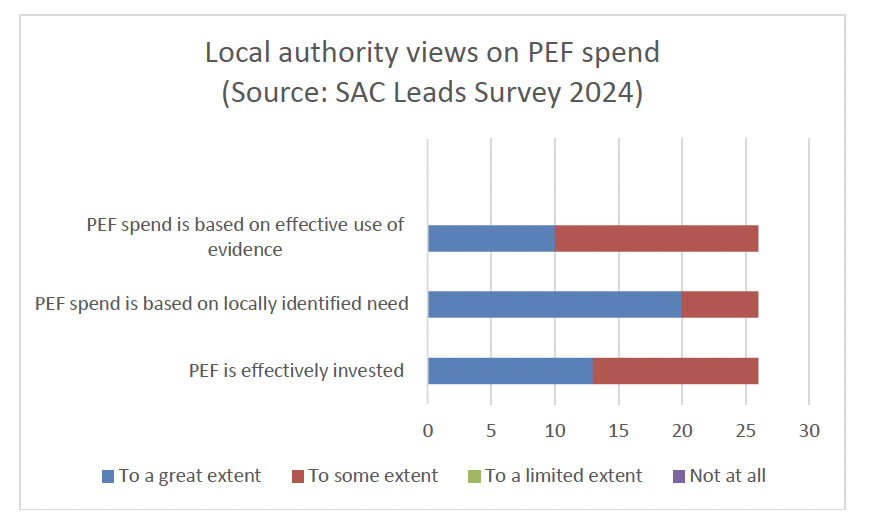
- National stakeholder perspectives on PEF were also broadly positive. One national stakeholder interviewee pointed specifically to a perception of improved headteacher confidence in relation to PEF over time, and that overall PEF is being invested effectively by schools in response to local needs. The importance of schools making the right decisions about what and how to spend PEF at the school level was recognised, and that there is no ‘one size fits all’ but rather dependent on the individual needs and context of the school. However, concerns regarding the time-limited nature of PEF, and lack of certainty over PEF beyond the current parliamentary term, were raised[26].
Care Experienced Children and Young People (CECYP) Fund
Building on existing learning, the evidence related to CECYP Fund implementation continues to indicate broadly very positive perceptions:
- CECYP Funding was viewed to have supported strategic decision-making to improve attainment or outcomes for care experienced children and young people, with mechanisms such as strategic groups and other oversight boards supporting collaborative working and facilitating joint working between education and social work, as well as with other partners such as health and third sector. The importance of joining up with The Promise governance structures was also raised.
- There was evidence of:
- innovative ways of working across funding streams, with CECYP working alongside PEF and other funding streams such as WFWF to provide specific bespoke support;
- budgets being assigned to specific post-holders to effectively support collaborative working;
- creation of specific posts within local authorities to support work related to care experienced children and young people.
- The role of Virtual School Headteachers in local authorities supported both by CECYP Fund, with strong links to the Scottish Attainment Challenge and to The Promise continues to be highlighted as a key element to supporting joint working and increasing capacity in this area. Collaboration and working across professional and service boundaries are viewed as key to the Virtual School Headteacher role, with a number of different models to the role in place across local authorities.
- CECYP is also viewed as having supported broader collaborative working within local authorities.
- There was however recognition that further improvements could be made to partnership working in some areas, and that there could also be improved longer-term planning, although the time-limited nature of funding was recognised as a challenge. Staffing availability and consistency could also present as challenges. Data access and alignment of data (such as between social work and education) was noted as at times problematic, and an area for potential improvement to support better joint working. More closely aligned professional learning was also highlighted as an area for improvement. Challenges related to measuring the impact of CECYP and setting appropriate Stretch Aims in relation to care experienced children and young people were also raised.
Alignment with other policies at the local authority level
There was evidence suggesting ASF is aligned with other policies at the local authority level and with funding streams. The evidence considered indicates:
- Alignment with other policies was highlighted on a broad range of fronts by respondents to the SAC Leads Local Authority Survey 2024 (see box below for examples). This included corporate objectives, children’s services, child poverty, children and young people’s planning partnership, corporate parenting and The Promise[27]. Alignment of planning with other funding streams such as Whole Family Wellbeing Fund[28] to avoid duplication of services was also highlighted.
ASF alignment with other relevant policies and funding streams: examples from local authorities
- SAC Lead a member of wider local authority Poverty Action Group.
- SAC Lead role in liaison with The Promise Lead in planning for the Whole Family Wellbeing Fund (WFWF) implementation.
- Virtual School Headteacher working closely with The Promise Lead to ensure vision for improved outcomes for care experienced children and young people at the forefront of planning.
- SAC Lead member of WFWF Governance Group, sharing information to help shape the development of the WFWF project.
Source: Scottish Attainment Challenge Local Authority Leads Survey 2024
- National stakeholders were broadly of the view that ASF was aligning with a range of policy areas, and particularly in relation to Tackling Child Poverty and The Promise. The Virtual School Headteacher roles which are in place in many local authorities through CECYP support policy alignment in relation to care experienced children and young people with links to GIRFEC[29], and to WFWF. The importance of implementing the UNCRC[30] was viewed as a key development which would further strengthen the focus on children’s rights to education.
Contact
Email: socialresearch@gov.scot
There is a problem
Thanks for your feedback